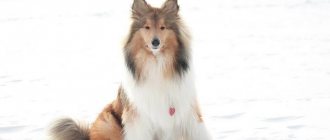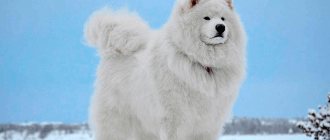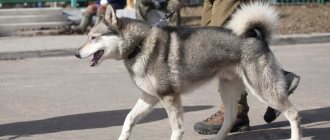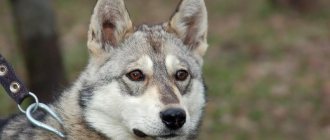History of the breed
The West Siberian Laika is a descendant of aboriginal hunting dogs that have lived beyond the Ural Range since time immemorial.
It is worth noting that until the beginning of the 20th century. In the taiga villages there lived many breeds of huskies, each of which had its own distinctive features and loyal fans among local hunters. There was no talk of division into breeds and intrabreed types at that time, so animals freely crossed with each other, giving humans the right to select the most successful “specimens.” Nevertheless, even in such conditions, the stratification into leaders and outsiders was quite natural. Therefore, when in 1939 there was talk of standardizing huskies, experts immediately turned their attention to the Mansi (Vogul) and Khanty (Ostyak) offspring, which had established themselves as excellent hunters of taiga animals. Also in 1939, a meeting of Soviet cynologists was held, at which five main breed types of animals were approved, which included the wards of the Khanty and Mansiysk fishermen. The purposeful breeding of the ancestors of West Siberian huskies began in the 40s of the 20th century. due to state necessity. The country waging war needed money, which could be obtained, among other things, from the sale of furs and meat. Well, it was up to Siberian hunters and their four-legged assistants to get this valuable product. According to the official version, the mission to popularize the breed was entrusted to the Krasnaya Zvezda nursery, although in fact, breeding and a kind of PR of animals were also carried out in breeding nurseries of the Novosibirsk, Sverdlovsk and Perm regions.
In 1947, the Soviet cynologist E.I. Shereshevsky proposed classifying domestic huskies according to the geographical principle, according to which the Khanty and Mansi offspring were united into a common, West Siberian group. The proposal was not immediately accepted for consideration, but in 1952 the section of northern hunting dogs was replenished with three new breeds - the West Siberian, Karelian-Finnish and Russian-European Laika. A sharp jump in the popularity of the ZSL occurred in the 60-70s, after which foreign breeders and cynological associations became interested in the animals. And in 1980, the breed was finally recognized by the FCI, which opened the way for it to international exhibitions and competitions.
Important point. It is not entirely correct to consider the West Siberian Laika as a pure descendant of Mansi and Khanty hunting dogs. The breed did not develop in isolation, so mixing the blood of other offspring into its phenotype was common. Experts are confident that today's WSLs have inherited part of the gene pool of the Udmurt, Ural, Nenets, Evenki and Zyryansky (Komi) Laikas, as well as some breed traits of German Shepherds.
Price
Before buying a dog, a potential owner must understand why he needs a husky in the first place. If you need a working or guard dog, you can purchase a puppy without documentation, but it must have working parents. Here, representatives of the breed may have some flaws in appearance, but they will have the required skills. Pets with documents will be needed for breeding and exhibitions.
- Russian-European huskies from working parents in the absence of a pedigree will cost in the range of 2,000 – 10,000 rubles. When preparing documents, the price increases to 10,000 - 40,000 rubles.
- East Siberian puppies 4000 - 5000 in the absence of documents, in them 10000 - 20000.
- The remaining varieties cost 3,000 – 5,000 rubles without pedigrees; its registration increases the cost at least twice.
Breed standard West Siberian Laika
The West Siberian Laika is a dog of a strong, albeit somewhat dry build, hardy and incredibly fast when it comes to chasing prey. By the way, this is one of those breeds whose representatives are affected by sexual dimorphism, so ZSL males are much larger than females. You can distinguish a purebred West Siberian Laika from a pack of mestizos by body proportions. In particular, the length of the body of purebred individuals significantly exceeds their height at the withers. In proportional terms, it looks like 103-107/100 in males and 104-108/100 in females. If you compare the height of the animal’s withers and rump, then the first will be a centimeter or two larger (in female dogs the discrepancy is smaller or absent altogether). Special requirements are also imposed on the front legs of the husky: their length must be equal to ½ the height of the pet at the withers.
Although the West Siberian Laika has been a factory breed for almost 80 years, puppies periodically appear in its litters, reminiscent in appearance of their Vogul-Ostyak ancestors. In this regard, cynologists distinguish two main intrabreed types of ZSL - Khanty and Mansi. Representatives of the first variety are distinguished by their comparative squatness, have a wide head in the shape of an equilateral triangle and a rich dog’s body, giving the dog’s silhouette additional volume. Mansi Laikas are usually taller and poorer dressed, their skulls are narrower, and their eyes are more round and expressive.
Head
The head of the West Siberian Laika is dry, elongated, triangular in shape. The skull is narrow (a feature most pronounced in females), with a flat or slightly rounded forehead. In general, the profile of the animal is not particularly prominent: the eyebrows of the ZSL are not too prominent, the line of the stop is smoothed. The dog's muzzle is wedge-shaped, equal in length to the skull.
Jaws and teeth
The purebred West Siberian Laika has a full set (42) of strong teeth and powerful jaws with a scissor bite.
Nose
The earlobe is of normal size, painted black. At the same time, for individuals with white fur, a lighter, brownish shade of the lobe is typical.
Eyes
The dog's oblong, dark brown eyes are slightly slanted. Another distinctive feature is that the eyeballs of the ZSL are set deeper than, for example, those of other varieties of huskies.
Ears
The ears of the West Siberian Laika are erect and have a regular triangular shape.
Neck
The dog's neck is elongated, well muscled, and dry.
Frame
The animal's sculpted withers smoothly transition into a straight, wide back, ending in a massive and somewhat inclined croup. The chest of the ZSL is deep and of good width. The abdomen is moderately tucked.
Limbs
The front legs of the West Siberian husky are even, spaced at a fairly distant distance from each other (wide set). The shoulder blades are long, strongly laid back, the elbows are pressed to the body, with developed joints that “look” back. The dog's hind legs are muscular, with long, strong thighs, strong knees and almost vertical metatarsals. The paws are oval in shape, with the hind legs being smaller in size than the front ones. The fingers of the ZSL are arched and collected, but the middle finger stands out somewhat from the general row due to its greater length.
Tail
Rolled into a “steering wheel” and thrown on its side or in the lumbar region. When unrolled, the tail hangs down to the hocks.
Wool
The coat of the West Siberian Laika is formed by moderately hard outer hair and a voluminous, insulating layer of undercoat. In the shoulder area the dog's fur grows thicker, resulting in a rich collar framing the dog's neck. The fur on the front of all four legs is relatively short, with soft “pants” on the hips. Small tufts of bristly hair also grow between the husky's toes, performing a protective function.
Colors
The animal's fur is most often colored in red, piebald, gray, red-brown and white tones. The following combinations are also acceptable: white with brown, gray, red, fawn spots, zone-piebald, zone-red.
Disqualifying defects of the breed
- Congenital malocclusions.
- Aggression or excessive indecisiveness.
- Jaw distortion.
- Behavioral and physical deviations that are too obvious.
- Absence of four or more teeth/presence of additional incisors.
- Drop or semi-erect ears.
- A cataract (clouding of the cornea), as well as the color of the iris interspersed with a shade that is unacceptable by the standard.
- The tail is too short or has an atypical shape (saber-shaped, straight, etc.).
- Short/not long enough coat.
- Albinism. Non-standard coat colors: blue, brindle, chocolate.
Norwegian
This breed has several names: Norwegian Laika, Moose Laika, Norwegian Elkhound. Dogs are indeed still used to hunt moose. They were developed in Scandinavia in 1877, which is the official date of recognition of the standard. It is believed that this is one of the most ancient Norwegian breeds.
There are two varieties: black and gray Elkhound. They differ only in color. Their format is extended. The body is dry, muscular, strong. The animals are smaller in size than their counterparts: 49-52 cm at the withers. They weigh 15-25 kg .
The Norwegian Husky is also called the Buhunda. It differs from its brother in functions: it has a guard shepherd function and is considered a farm dog. These dogs also have light red and wheaten colors. In all other respects the breeds are similar.
Caring for these Laikas is standard : regular brushing, twice a day bathing (per year), active long walks. Suitable only for outdoor and aviary keeping; they do not tolerate heat.
A purebred puppy with all documents can be purchased for 20,000-40,000 rubles . Without a pedigree, a dog will cost less - up to 10,000 rubles .
We also recommend that you read the article: “White, fluffy bundle of happiness – Samoyed dog (Laika).”
Character of the West Siberian Laika
Laikas are like that... huskies and West Siberian are no exception. Therefore, before acquiring such an active pet, it is better to ask yourself the question: do I have enough energy and patience so as not to turn the dog’s and my own existence into an eternal struggle for interests? The “talkativeness” of the breed should not be discounted. Barking for an SSL is not just another attempt to get on your nerves, but a means of communication, so don’t expect to hear a loud “Woof!” pet only for hunting.
Their agility, innate playfulness and curiosity make West Siberian Laikas wonderful hunters and athletes, but they are not the most outstanding companions. Accordingly, if seasonal trips for trophies do not interest you as such, there is no point in getting involved with the breed. Chasing an animal for a husky is perhaps the main purpose of its existence, and depriving an animal of this joy is simply cruel.
For the West Siberian Laika, any person is either a friend or a future buddy, which, of course, affects the dog’s security and watchdog qualities. On the one hand, the animal is not deprived of them and, with proper training, is capable of driving away unwanted persons from its home. On the other hand, too ardent defense of the owner’s property indicates the instability of the four-legged comrade’s psyche, which is unacceptable in principle for a hunting breed.
West Siberian huskies respect the laws of the pack and never measure their strength with those who are weaker, so it is quite reasonable to leave them to look after children, to whom the dogs are friendly and patronizing. It is believed that APs are inclined to demonstrate independence and should not be limited in this. Nevertheless, representatives of this breed will not fight with a person for the right to be a leader for any price. The owner of a husky is a friend and mentor, with whom she sees no point in competing, because working in pairs is much more interesting and correct.
The hunting instincts of representatives of the West Siberian Laika breed make themselves felt not only in the wild. In particular, SAWs are very intolerant of any animals they are not personally acquainted with. Experienced dog lovers also know that keeping several ZSL males in one territory is an amateur’s pleasure with a very consistent character, since the dogs almost never stop competing with each other and finding out “who’s boss.”
Education and training
The West Siberian Laika is not a circus dog, so do not waste time with it learning acrobatic tricks, which are essentially of no use to a hunting breed. It is also important to take into account the psychological characteristics of SSL: slight stubbornness, self-will, loss of interest in learning - all this will certainly occur, although not on a very outstanding scale. It is advisable to start raising and training a puppy from the age of 3 months using standard methods, that is, try not to overtire the baby, try to introduce him to new behavior patterns through play, etc. It is good if it is possible to take your pet to group classes. West Siberian Laikas have very strong gregarious and competitive instincts, which is why they always work more actively in a team. By the way, you can practice hunting skills with a dog only after it has mastered the basic obedience commands (preferably passing OKD).
Pay special attention to prohibitive commands. Excessive independence inherent in the breed should be easily corrected. If the dog does not respond to the ban, this is fraught with big trouble. In particular, it costs nothing for an SSL to run away during a walk, carried away by the pursuit of a gaping cat. Don’t go to the other extreme and don’t train your pet. The West Siberian Laika is not a terry intellectual and a wearer of slippers, but a strong, merciless hunter, capable of mastering the basic principles of etiquette exactly as much as is necessary in order to get along with a person and not create unnecessary problems for him.
Choosing a pet
Before you start looking for a puppy, you should determine why you need a dog. Do you need a hunter or a good companion? If you decide that you need a hunting dog, then puppies should be purchased from the best breed of Laikas. The puppy's parents must have the following breed characteristics:
- oblique eyelid incision;
- erect ears;
- Brown eyes;
- sharp muzzle with dark nose;
- fluffy tail;
- soft undercoat;
- The spine is straight and hard.
A very good sign in the ZSL is the presence of a tail, which is wrapped in a ring.
The pet is kind and balanced.
It must be remembered that an animal of this breed develops very quickly. That is why it is better to buy a dog at the age of 4 weeks. One should already have ears in the shape of a triangle, a gentle transition from the forehead to the muzzle, and there should be no folds on the lips.
Hunting with the West Siberian Laika
In terms of hunting, the West Siberian Laika is a real all-rounder, capable of getting any game for its adored owner, from squirrels to bears. The dog’s upper and lower senses, which are equally well developed in representatives of this breed, innate viscosity (perseverance in pursuing a goal and searching for a scent) and a ringing bark help the dog not to lose the status of a super hunter. Another feature of the breed is the ability to work on the old track, which is considered aerobatics and is not given to all representatives of the section.
If you plan to raise your pet to be a full-fledged earner, and not a useless “holder of a hunting diploma,” it is better to train the animal not on training grounds, but in natural conditions, where the animal is real, and not stunned by the endless barking of four-legged “students,” and the danger is real. By the way, it is absolutely not necessary to make a West Siberian husky “a master of all trades.” No matter how remarkably smart a dog is, it is not able to catch a sable for you today, a wild boar tomorrow, and a bear a week later. Of course, there are exceptions, but this is an innate gift that is found only in a select few.
The degree of development of hunting instincts in West Siberian huskies depends on how often the dog finds itself in the wild. If you are used to taking your pet into the forest a couple of times a season, then don’t expect him to demonstrate any superpowers. For a proper husky, going hunting should not be a holiday, but a natural change of location, where the animal must feel as confident as in its own enclosure. By the way, it’s better not to delay training. At 5-6 months, the puppy is already ready to periodically walk with the owner in the forest, practicing walking nearby and getting used to the surrounding smells and sounds. 10-month-old adolescents can begin to be introduced to the beast. It’s great if an adult hunting dog already lives in the house. In this case, the puppy will have someone to learn from. And keep in mind that if by the age of 2 the West Siberian Laika does not begin to work with game, then it will be pointless to work with it.
West Siberian Laika nurseries
| Nurseries | Federation | City |
| Kennel "... from Anna's Empire" | RFOS | Kaliningrad |
| Nursery Vyat Galena | OANKOO/Fauna | Kirov |
| Kennel Zolotaya Korona | OANKOO/Fauna | Nizhny Tagil |
| Nursery from Antagrad | OANKOO/Fauna | Saint Petersburg |
| Nursery IZ POVAROVO | RFSS | Solnechnogorsk |
| Kennel Constanta Ross | OANKOO/Fauna | Moscow |
| Kennel Maxianna | OANKOO/Fauna | Ukhta |
| Kennel Hunting Gladiator | RFLS | Serpukhov |
| Kennel Siberian Hunting | RFSS | Tyumen |
| Nursery Skorokirzha | OANKOO/Fauna | Mizhgorye |
| Kennel BLACK STRANGER | RFLS | Saint Petersburg |
| Kennel C DONSKOY STAY | RFOS | Rostov-on-Don |
Source - https://rkf.online/organizations?organization_type=3&active_rkf_user=false&activated=false
For more information, see the official website of the RKF.
Maintenance and care
West Siberian huskies easily tolerate Russian frosts and are quite adapted to extreme weather conditions, so the best place of residence for a working dog would be an enclosure in the courtyard of a private house. In addition, for a comfortable existence of a pet, a pet requires a lot of free space, so the option of moving a pet into an apartment is regarded as the worst possible. It is also important to understand that, unlike their Russian-Finnish counterparts, West Siberian Laikas have difficulty getting used to life in a metropolis, or indeed any city. These restless “Siberians” prefer the countryside or at least the urban outskirts.
List of things needed to keep a West Siberian Laika:
- insulated booth with bedding;
- bowls for food and drink;
- toys;
- leash for walking (from 2 m) and collar;
- muzzle;
- collar tracker with GPS (for hunting enthusiasts).
You won’t be able to place a West Siberian husky in a booth or enclosure and relax, since you will have to change the animal’s straw bedding weekly and remove its waste products at least once a day. In addition, once a month it is recommended to completely disinfect the enclosure.
Karelo-Finnish
A breed bred in Russia, more specifically, in Karelia. Adapted for hunting birds, furs, and small ungulates. Previously, the standard separated Karelo-Finnish Laikas and Finnish Spitz. Now these dogs are considered one breed line.
Recognized since 1935 by the International Canine Organization, they belong to the 5th group and 2nd section. Since 2006, 2 livestock have been indicated: Russian and Finnish.
The dog is of a square format, the shortest among all its brothers: at the withers, representatives reach 42-50 cm , weigh about 7-12 kg . A special difference is the juicy red-red color .
Like all huskies, Karelians love freedom and space. They can live in an apartment due to their small size, but it is better to provide them with an enclosure or yard. The area must be fenced. These huskies do not tolerate hot weather well, so it is better to breed them in a temperate climate. Dogs need proper coat care.
Read a detailed article about the breed: “Karelo-Finnish Laika (Karelka) is a Russian hunting breed.”
These animals can be considered one of the most expensive among their brethren. But it is possible to find a puppy without a pedigree for 5-10 thousand rubles . Dogs with status will cost 15-70 thousand rubles .
Hygiene
The West Siberian Laika is an unpretentious working dog and there is no point in traveling with it to grooming salons. Yes, during the molting period (autumn-spring), the ZSL’s fur will have to be combed with a sparse comb, sometimes using a furminator, but otherwise not much time is spent on caring for and creating the image of the pet. Laikas are rarely washed: mainly before exhibitions or when the animal is thoroughly dirty. Moreover, in the summer, occasional swimming in open waters will be enough.
Working and well-walked dogs do not need to have their nails trimmed at all. For individuals that are not particularly active, the plate is trimmed once a month with a nail clipper for large breeds. At the same time, it is better to examine the eyes and ears of the inhabitants of enclosures daily, so as not to miss or cause inflammation. One of the main working “tools” of the West Siberian Laika is its paws; accordingly, after hunting and walking, they should be given increased attention. Minor cuts, scratches, and other injuries should be treated immediately with veterinary ointments or creams. A good help would be vegetable oils, which are used to lubricate the paw pads to prevent the appearance of cracks and peeling on them.
Caring for your husky
The West Siberian Laika, which lives in an enclosure and regularly takes part in hunting, does not require special care. These animals are very unpretentious. The dog loses its old undercoat naturally, wading through thorny bushes in pursuit of the animal. The claws also grind down without human help.
What you should do regularly:
- check the dog for ticks upon returning from the forest, park, etc.;
- carry out deworming – once every 3 months;
- examine the ears, eyes, nose, visible mucous membranes - daily;
- wash with dog detergent – 2 times a year.
If the husky is a city dweller, regular combing will have to be added to these procedures. It is necessary to accustom a puppy to this from a very early age: the dog’s undercoat is thick and dense, so the procedure may not seem the most pleasant to the animal. You can use a furminator or a powder brush. Start with the head, then comb out the body, legs and tail.
Walking and training
The West Siberian Laika, which does not fully realize its energy potential, becomes depressed, goes bald and often gains weight. Therefore, in order for the pet to be vigorous, healthy and live the entire life allotted to it, it is better to load it to the maximum. It is necessary to go out with the dog to get some air at least twice, and preferably three times a day, and the duration of the walk should be at least an hour. Be sure to include in these 60 minutes not only standard runs on a leash, but also elements of training, as well as active games. In order not to misbehave at home, the West Siberian Laika must give all its best outdoors, so ordinary festivities are not enough here.
When taking your ward out to a park, square or forest belt, do not lose vigilance. ZSL males are captivating natures and instantly disappear from sight if potential prey looms on the horizon. The best prevention of this behavior is a standard leash, which allows you to control the movement of the animal. In general, once on the street, West Siberian huskies demonstrate eerie independence and pay almost no attention to their owner, preferring to mind their own business. Sometimes it is difficult to “get through” to a dog, but it is necessary to do this, since it is the overly self-confident and uncontrollable individuals that most often disappear during the hunt.
Behavior and temperament
Laika becomes attached to its owner with invisible but inextricable bonds. Such exceptional love for a person sometimes plays a cruel joke on a dog: huskies rarely gain confidence in their new owner if they change home for some reason.
Treats children well , considering them part of his pack.
Husky puppies begin to fight for leadership as soon as they open their eyes. By the age of eight weeks, after a series of fights, a clear hierarchy is built among the babies.
If you take another animal into a family with a husky, conflict situations and even fights are possible. Small animals may be treated as prey. The West Siberian Laika will get along well with the animal that lived in the house before it arrived.
Feeding
West Siberian huskies prefer animal protein to replenish the energy spent on hunting and training. Any lean variety of meat is suitable here, from lamb to beef, and it is better if it is substandard - sinewy trimmings, weathered pieces, etc. The meat is given raw or slightly scalded, but in no case boiled. Once a week, offal and fish (preferably the cod family) should appear in the dog’s bowl, and the size of the usual portion will have to be increased by a third.
Low-fat sour milk, porridge from coarse cereals, thermally processed seasonal vegetables also diversify the ZSL menu. You should not neglect vitamin supplements, since few people succeed in balancing their diet with the help of exclusively natural products. Feeding the West Siberian husky “drying” is regarded as a completely acceptable option, but in this case the desire to save money will have to be abandoned. Low-quality feed will not only not satiate the animal, but will also ruin its digestive and urinary systems.
Important: West Siberian huskies are usually not fed before a hunt.
Health of the West Siberian Laika
Centuries of natural selection and the harsh climate of the West Siberian Plain have polished the health of animals to a standard state. As a result: West Siberian huskies have excellent immunity and virtually no genetic diseases. The main enemy of the breed is forced physical inactivity, which provokes a lot of ailments, ranging from obesity to joint diseases. Hunting trips also pose a danger to the health of dogs. Carried away by the pursuit of an animal, huskies can be injured by flying into trees, although they recover from such “accidents” surprisingly quickly. Animals are often bitten by snakes, ticks and small predators, so timely vaccination against rabies and treatment against ectoparasites will not be superfluous. In addition, FAWs can become infected with worms from caught and eaten game, so do not forget to replenish your veterinary medicine cabinet with anthelmintic medications.
How to choose a puppy
- West Siberian Laika males are more independent, prone to running away, and also often sort things out in the pack. At the same time, the “boys” have distinct breed characteristics and look very colorful. ZSL “girls” are less impressive in appearance, but they are more flexible and easier to learn. The only disadvantage of females is regular estrus, which interferes with hunting.
- When choosing a puppy for hunting, take an interest in the working achievements of its parents, or better yet, look at one of them in action.
- Give preference to apparently healthy, moderately well-fed babies who react to your arrival with curiosity and loud barking.
- Don’t put too much faith in the old, “old-fashioned” methods of selecting the best puppy (testing on a log, squeezing the husky’s belly with your fingers, selecting by the color of the paw pads), which are so popular among inveterate dog lovers. In 99% of cases, such “tests” do not provide any guarantee that the individual you choose will be ideal.
- Check with the breeder what kind of litter the bitch has and when the previous one was. It is optimal if the dog gives birth no more than once a year. In addition, many dog handlers believe that the first litter of West Siberian Laikas is not the most successful.
- Puppies can be tested for their hearing and smell acuity. In the first case, you need to wait until the kids fall asleep and snap your fingers over them. The puppy that reacts first to noise will have the most outstanding hearing. The sense of smell is tested with food by placing a bowl of food at a distance and observing which of the puppies will be the first to smell the appetizing smell.
Buy | sell
| I'll give it to good hands Moscow April 18, 2020 Domestic mixed-breed puppies, 2 months old, g/w, different colors, will grow to be of medium size, very affectionate, cheerful and sociable, waiting for a reliable… |
| I'll give it to good handsMoscowApril 5, 2020 Cheerful Butch is looking for a home! Age: 3.5 years. Weight: 34 kg. Height: 65 cm at the withers. Healthy, vaccinated, neutered. Temperament/character: choleric and extrovert. ... |
| I'll give it to good hands Moscow March 29, 2020 Beautiful mixed-breed husky puppies, 2 months old, very smart, domestic, different colors: gray, black, black and white. Very good dogs for a family with… |
| 10 Belgorod8 February 2019 West Siberian Laika puppies, born 12/21/19, two boys and two girls |
| 5000 NovosibirskOctober 11, 2018 Selling West Siberian Laechkas. Purebred. Parents are workers. D. r. 09/04/2022. |
| 5000 Krasnodar25 April 2018 Laika puppies, born on March 13th. 1 boy left -5000?, and 3 girls -3000? . Parents with a passport. Mom is pure white. I'll give in!!! |
| 40000 January 17, 2018 I am selling a male West Siberian Laika, date of birth November 17, 2016, origin (Zyar VPKOS No. 1987/11 - Umka St No. 391-1631/LZS) Male with character, ... |
| I'll give it to good handsMoscowDecember 10, 2017 Our dear Linda looks a little like a cute fox with a neat face and house-like ears. Linda is a West Siberian Laika mix. Very devoted... |
| I'll give it to good hands Moscow November 25, 2017 We present to your attention a West Siberian husky mixed breed named Chuk. Our Chuk looks like both his mother Laika and a real gray wolf. Special charm... |
| 12000 September 18, 2017 West Siberian Laika puppies with pedigree for sale. There are 4 males and 1 female in the litter. Parents at field tests have diplomas in bear, badger, ... |
| Norilsk27 August 2017 Husky puppies for sale. The West Siberian Laika is a Russian breed of universal hunting dog. A dog of average and above average height, strong, dry... |
| 13000 May 20, 2017 West Siberian Laika puppies for sale from working studs with a pedigree. Born on April 18, 2022. There are 3 males in the litter. and 3 females. Father is a worker... |
| I'll give 100 to good handsMoscowApril 5, 2017 I will give into caring and loving hands a very active, intelligent, kind and affectionate girl, a West Siberian husky mix. Age 5 months. Bonya has been processed... |
| 20000 Murmansk February 27, 2017 I will sell puppies with a pedigree (stamp and metric of the puppy). Born January 13, 2022. Working parents (confirmed by diplomas). Call for details. |
| 12000 Krasnoyarsk February 6, 2017 West Siberian Laika puppies for sale. The parents are of high breed, have EXCELLENT exterior grades, diplomas in bear, boar, badger, and squirrel. ... |
| 15000 ShaturaDecember 20, 2016 1. Breed: ZSL 2. Number of puppies (males/females): 2/2 3. Date of birth of puppies: October 23, 2016 4. Color: male No. 1: gray-red with white male No. 2:… |
| 1000 mating Podolsk November 8, 2016 Male ZSL for mating in Podolsk, Moscow region. From working parents. Works properly on squirrels. We can take two or three puppies. |
| matingBryanskOctober 24, 2016 Male Trans-Siberian Laika, with pedigree, age 2 years. |
| 12000 October 13, 2016 Laika puppies for sale. Breed: West Siberian Laika Number of puppies in the litter (males/females): 3/3 Date of birth of puppies: September 6, 2016 Color:… |
| 10000 September 12, 2016 I will sell West Siberian Laika puppies from working parents. Date of birth 08/22/2016 Parents are commercial hunting dogs, they work in the taiga fur... |
| Istra12 July 2016 wonderful puppies with excellent pedigree from real hunters. boys and girls. Inexpensive. Born May 30, 2016 |
| 5000 Novomoskovsk16 May 2016 Zapodnosiberian Laika puppies mom and dad with documents |
| 10000 KrasnoyarskMay 2, 2016 I will sell LZS puppies from working fur dogs. The puppies were born on March 25th. There are 2 males and 2 females in the litter. |
| I'll give it to good hands Kazan April 19, 2016 We will give a West Siberian husky puppy to our home. she is 1.5 months old, very cute. . . . . it's hard for her in the apartment |
| 10000 Krasnoyarsk April 7, 2016 I will sell Laika puppies from working, purebred Laikas. Puppies were born on February 20, 2016. Parents in the taiga work on sable, elk, badger and wood grouse. For sale… |
| 4500 Ryazan April 3, 2016 Selling puppies from working parents. bargaining is appropriate |
| 20000 Lyubertsy2 March 2016 5 puppies for sale, gray red color. Distribution of puppies, February 19. Father of the puppies p.ch. Grip line p.p.p.p. Zuban Vronsky A.Yu. bitch then male p.p. Vagaya… |
| matingKirovFebruary 25, 2016 We offer West Siberian Laika, male, 3 years old. Thoroughbred, with documents. |
| 1000 February 10, 2016 I sell West Siberian Laika puppies, born November 10, 2015. Parents are workers (ungulates, fur). Two bitches left. 8 (960) 545-98-11(Margarita) |
| matingSochiJanuary 27, 2016 |











